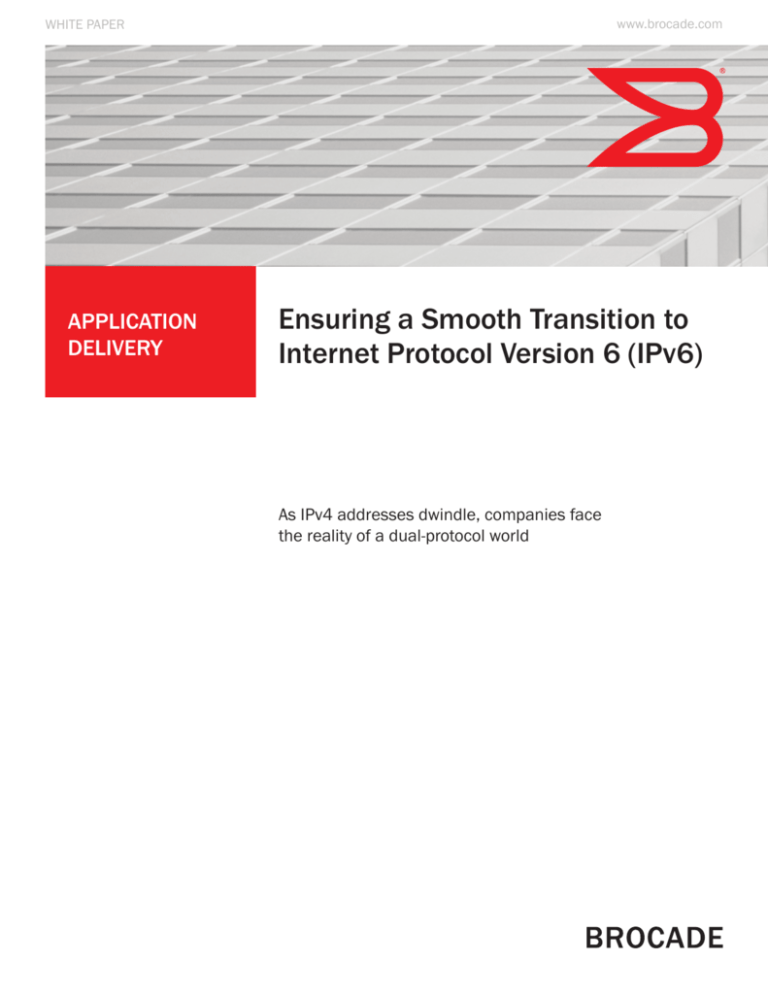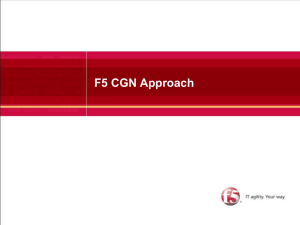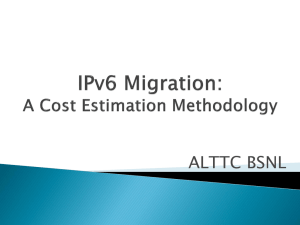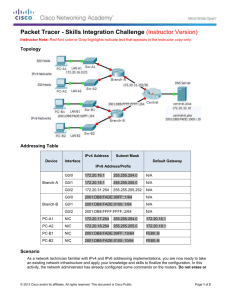
www.brocade.com
WHITE PAPER
APPLICATION
DELIVERY
Ensuring a Smooth Transition to
Internet Protocol Version 6 (IPv6)
As IPv4 addresses dwindle, companies face
the reality of a dual-protocol world
The transition from the IPv4 protocol to the IPv6 protocol represents
a significant challenge to service providers, hosting services,
e-commerce companies, and government agencies. They must find
ways to accommodate end users and Customer-Premises Equipment
(CPE) devices that may be using either protocol.
This white paper examines four transition technologies along
with their advantages and disadvantages. Brocade is offering its
customers a transition path to the new wave of Internet technologies
while continuing to utilize customers’ existing infrastructure.
INTRODUCTION
When the Internet Assigned Numbers Authority (IANA) standardized IPv4 in 1981, no one
could have foreseen that its seemingly plentiful pool of 4 billion addresses would become
depleted. But according to Internet World Stats, Internet usage grew by 444.8 percent
between 2000 and 2010.1 With the increasing deployment of Internet-enabled mobile
devices, smart-grid devices, and cloud-based applications, the spike in usage is only going to
increase in this decade.
Indeed, on February 3, 2011, the IANA allocated its last block of IPv4 addresses to five
Regional Internet Registries (RIRs) around the world. These registries assign IP addresses
to Internet Service Providers (ISPs), which in turn issue IP addresses for home and office
machines, smart phones, and other Internet-enabled devices.
Taking the place of the old protocol, IPv6 is designed not only to solve IPv4’s address
scaling challenge but also to rectify other shortcomings. For instance, it provides a variety of
mechanisms to increase both routing efficiency and management simplicity (see box, “What’s
New in IPv6”).
Because of the preponderance of new capabilities, however, the designers of IPv6 were
not able to make it backward-compatible with IPv4. This means devices speaking different
versions of Internet Protocol can no longer communicate with each other natively, and
applications that rely on such communication will fail.
1
2
http://www.internetworldstats.com/stats.htm
FINDING THE RIGHT TRANSITION TECHNIQUE
The industry faces a challenging transition while it moves carefully from its current
IPv4-capable routers, switches, servers, and applications to IPv6-ready devices. Service
providers—whether they are providing content, hosting services, or Internet access—cannot
add or accommodate new customers unless their content is equally accessible to both IPv4
and IPv6 users.
Similarly, e-commerce sites need to accommodate customers without knowing which protocol
those customers’ client devices use. At the same time, multiple federal governments around
the world have enacted regulations forcing their agencies to adopt IPv6. As a result, service
providers, hosting services, and other content providers need to investigate transition
approaches during the evolution period. Today there are several technologies that create
a bridge between IPv4 and IPv6; they use such techniques as translation, coexistence,
tunneling, overlay, and more. The primary technologies include the following:
•NAT444
•NAT64
•Dual-Stack Lite
•6rd
Each technology has its advantages and disadvantages, which we’ll consider.
Translation: NAT444
In a traditional address-translation mechanism using Network Address Translation (NAT), an
IP address from a private address pool is translated to a globally unique, publicly reachable IP
address. Optionally, the mechanism translates source port information so that many private
IP addresses can share a limited number of global IP addresses.
3
NAT444 is essentially an extension to the traditional NAT mechanism. It involves two layers
of address and port translation. The first takes place at the Customer-Premises Equipment
(CPE) and the second at the ISP, which uses a capability known as Large-Scale NAT (LSN).
The term NAT444 signifies translation from one IPv4 block to a second IPv4 block, followed
by a third IPv4 block. The first IPv4 block is a private address at the CPE. The second one
is another private IP address block between the CPE and the ISP, and the third is a globally
reachable public address block (see Figure 1).
Figure 1.
How NAT444 works.
Internet
Public IPv4
Address Block
Large-Scale
NAT (LSN)
Private IPv4
Address Block
Private IPv4
Address Block
CPE
4
Advantages of NAT444
•It does not require the replacement of existing CPE devices.
•It utilizes proven NAT technology.
•It does not require changing other network elements such as Domain Name System (DNS).
Disadvantages of NAT444
•There could be a potential overlap between the customer’s private address block and the
private address block used between the CPE and the service provider. This could result in
the misrouting of packets.
•The routing of packets between two different customers behind the same LSN is also
challenging and may require a change in firewall policies.
•The classic disadvantages of NAT technology, such as the masking of end-user IP
addresses and breaking end-to-end transparency, apply to NAT444 as well. In fact, NAT444
complicates communication even more for applications that embed IP addresses inside
the payload of the packet, such as media applications, because it involves invoking the NAT
mechanism twice for every transmission.
•As an IPv4 address-preservation technique, it does not offer any longer-term IPv6
transition benefits.
•Doing NAT at two locations negatively affects performance.
5
Coexistence: NAT64
The Network (and Port) Address Translation between IPv6 to IPv4 model—generally known as
NAT64—is a mechanism for both the transition to IPv6 and the coexistence of IPv4 with IPv6.
It works together with DNS64, essentially a DNS translation service, to enable client-server
communication between an IPv6-only client and an IPv4-only server and vice versa. It allows
for peer-to-peer communication where communication can originate from an end-node running
either of the two protocols. NAT64 utilizes a preassigned IPv6 prefix to algorithmically translate
IPv4 addresses of IPv4 servers. Similarly, it translates the IPv6 addresses of IPv6 servers to and
from IPv4 addresses by installing mappings (see Figure 2). Overall, the NAT64 model offers a
non-intrusive and seamless transition path for organizations looking to explore IPv6.
Advantages of NAT64
•It is completely transparent to end-users because address translation occurs at the service
provider network edge and it involves no change in client-end CPE devices. Thus it can be
an extremely cost-effective and practical solution.
•It allows for transition to IPv6 while preserving existing IPv4-based infrastructure. It
facilitates coexistence of IPv4-only and IPv6-only devices while ensuring seamless
communication between the two during the transition period.
Disadvantages of NAT64
•It involves translating addresses between IPv4 and IPv6, resulting in potential loss of
originating client IP addresses unless they are captured through some other means.
•Address translation requires processing power and can negatively affect overall system
performance if it’s not designed correctly.
Figure 2.
How NAT64 works.
DNS64 server
IPv6
IPv4
IPv6 + IPv4
NAT64 Gateway
6
Tunneling: Dual-Stack Lite
Dual-Stack Lite (DS Lite) is a tunneling technique that carries IPv4 traffic from the CPE over
an IPv6 link between the CPE and its service provider. When traffic originates from an IPv4
device at a customer location, the DS Lite mechanism encapsulates it inside an IPv6 packet
for transport to the provider network. At the provider’s end, the mechanism reverses the
process on the packet and uses LSN to reach the appropriate IPv4 destination on the Internet
(see Figure 3). Because the DS Lite model relies on IPv6 technology in the provider core, it
can also route IPv6 packets between IPv6-only end points.
Figure 3.
How Dual-Stack Lite works.
IPv6 Internet
IPv4 Internet
LSN
Service Provider
IPv6 Link
Home
Gateway
2001:aaaa:bbbb:cccc::1
Customer
10.1.1.1
7
Advantages of DS Lite
•It mitigates the routing challenge between two customers behind the same LSN device.
•It enables simultaneous connectivity for IPv6 clients communicating with IPv6 resources
on the Internet and IPv4 clients communicating with IPv4 resources on the Internet.
Disadvantages of DS Lite
•It requires expensive upgrading of CPE devices, a cost service providers may not want
to cover.
•It does not provide interconnectivity between IPv4 devices and IPv6 devices, which will
eventually be required for IPv4-to-IPv6 transition.
Overlay: 6rd
The basic principle of the 6rd model is to deploy IPv6 over the existing IPv4 infrastructure
of service providers (the rd in 6rd stands for “rapid deployment”). The mechanism relies
upon algorithmic mapping between IPv6 and IPv4 addresses assigned for use within the
service provider network. A 6rd mechanism requires deploying 6rd-aware CPE and one or
more 6rd-aware border relay routers. The CPE device encapsulates IPv6 packets, which are
then carried over the service provider’s IPv4 network to border relay routers. The 6rd border
relay router then decapsulates the packet and forwards it natively to an IPv6 network (see
Figure 4). The model enables service providers to offer IPv6 services alongside IPv4 services,
while making minimal upgrades to their existing IPv4 infrastructure. The model can be
decommissioned upon completion of a service provider’s IPv4 network migration to a dualstack model.
6rd
CPE
Figure 4.
How 6rd works.
IPv6
Clients
IPv6/IPv4
ISP Network
IPv4
6rd border
relay
IPv6 Internet
IPv4 Internet
8
Advantage of 6rd
•It enables service providers to quickly offer IPv6 services without making forklift upgrades
to existing IPv4 infrastructures.
Disadvantages of 6rd
•It requires upgrading CPE devices. Service providers can easily accommodate new
customers with new equipment, but it may not be economical to upgrade existing
customers.
•It does not offer interconnectivity between IPv4 and IPv6 protocols.
WHICH PATH TO FOLLOW?
One question continues to dawn upon service providers and enterprises as they face the
transition from IPv4 to IPv6: How soon does the transition decision need to be made?
IPv4 pundits argue that there are still millions of available IPv4 addresses, and technologies
such as NAT444 and LSN will help service providers accommodate new users for several
years. Alternatively, IPv6 loyalists—citing the increasing deluge of new mobile devices, IPv6only smart-grid capabilities, and cloud applications—recommend a more urgent move to IPv6.
Regardless of these two views, it’s clear that a two-protocol world of IPv4-only and IPv6-only
users is imminent. No matter which path organizations choose, they need to start planning
a pragmatic transition to IPv6 using models and methods that keep their costs down and
upgrade options open.
HOW BROCADE CAN HELP
For organizations to make the transition smoothly and without interruption, Brocade
recommends that organizations impacted by the move to IPv6 should have their vendors
address these questions:
•Which features are available with IPv6?
•Does the equipment meet performance requirements for IPv6?
•What is the impact of adding IPv6 to existing network devices?
•Can the device provide the necessary intelligence when an address is translated from one
format to another?
Traditional Layer 3 routers can provide simple address translation between IPv4 and IPv6
addresses; however, they do not offer any mechanism to maintain address intelligence
between two end points. For example, some applications rely heavily on source IP address
of the originating client for auditing and tracking transactions, and for maintaining integrity
of transactions.
9
An application delivery switch not only provides address translation, but also offers a
mechanism to retain address information between two end points. For example, an
application delivery switch can leverage HTTP capabilities to insert the source-IP address
of an originator into a custom header so that back-end application servers can utilize it for
tracking purposes.
To facilitate seamless communication with the new breed of IPv6-only customers in addition
to IPv4 customers, the Brocade ServerIron ADX Series offers a simple and cost-effective
transition path to IPv6 using a standards-based NAT64 gateway.
Topology A: The NAT64 gateway capabilities of Brocade ServerIron ADX enables organizations
to bring new IPv6 customers onboard while utilizing their existing IPv4-based infrastructures.
Topology B: Similarly, Brocade ServerIron ADX enables organizations to offer new IPv6-based
services to their existing IPv4 clients.
Topology C: Organizations can leverage the IPv6 application-delivery capabilities of Brocade
ServerIron ADX to ensure equal service access by IPv4 and IPv6 users while distributing
traffic among existing IPv4-only application servers. The IT team at Brocade is currently using
this technology to deliver three critical Internet services—HTTP, DNS, and e-mail—in native
IPv6 format.
In addition, Brocade delivers a comprehensive portfolio of products that deliver highperformance, and feature-rich IPv4 and IPv6 switching and routing solutions.
Figure 5. ServerIron ADX NAT64 gateway
enables a seamless transition to IPv6.
Topology A
Topology B
IPv4
Resources
Topology C
IPv6
Resources
IPv6 App
Servers
IPv4 App
Servers
Domain Name
System (DNS)
Server
ADX NAT64
Gateway
ADX NAT64
Gateway
DNS
Server
IPv6 Clients
to IPv4
Servers
IPv6 Clients
IPv6
IPv4 NAT
Brings new IPv6 clients
onboard for existing
IPv4 applications
10
IPv6
VIP
ADX
IPv4 Clients to
IPv6 Servers
IPv4Only
IPv4Only
IPv4
IPv6 NAT
Connects legacy IPv4
clients to new IPv6
resources
IPv6 Clients
IPv6
IPv4 NAT
Load balancing IPv4
application servers
while enabling service
for IPv6 clients
CONCLUSION
SEE ALSO
The Brocade ServerIron ADX Series helps facilitate seamless migration to strategic Internet
technologies such as IPv6, helping organizations achieve continuity and infrastructure
simplicity. It is a purpose-built platform that delivers unmatched performance value.
http://www.brocade.com/adx
WHAT’S NEW IN IPV6
The IPv6 protocol brings a variety of new mechanisms to improve Internet reliability.
These include the following:
•Significantly large address space
•Simplified network management using stateless auto-configuration of nodes
http://www.brocade.com/downloads/
documents/at_a_glance/SI_ADX_12.2_
IPv6_GA-AG-00.pdf
REFERENCES
(sources and more information)
IPv4 Address Depletion
http://www.nro.net/news/ipv4-free-pooldepleted
•Routing efficiency due to use of fixed-length headers
NAT444
•Reduction in network processor overhead due to reduced fragmentation
http://tools.ietf.org/html/draft-shirasakinat444-03
•Improved security (IPsec is built-in)
•Well-defined flow labels for Quality of Service
NAT64
•End-to-end address transparency
http://datatracker.ietf.org/doc/draftietf-behave-v6v4-xlate-stateful/
For more information about Brocade solutions, visit www.brocade.com.
Dual-Stack Lite
http://datatracker.ietf.org/doc/draft-ietfsoftwire-dual-stack-lite/
6rd
http://datatracker.ietf.org/doc/rfc5969/
11
www.brocade.com
WHITE PAPER
Corporate Headquarters
San Jose, CA USA
T: +1-408-333-8000
info@brocade.com
European Headquarters
Geneva, Switzerland
T: +41-22-799-56-40
emea-info@brocade.com
Asia Pacific Headquarters
Singapore
T: +65-6538-4700
apac-info@brocade.com
© 2011 Brocade Communications Systems, Inc. All Rights Reserved. 03/11 GA-WP-1574-00
Brocade, the B-wing symbol, BigIron, DCFM, DCX, Fabric OS, FastIron, IronView, NetIron, SAN Health, ServerIron,
TurboIron, and Wingspan are registered trademarks, and Brocade Assurance, Brocade NET Health, Brocade One,
Extraordinary Networks, MyBrocade, VCS, and VDX are trademarks of Brocade Communications Systems, Inc., in the
United States and/or in other countries. Other brands, products, or service names mentioned are or may be trademarks
or service marks of their respective owners.
Notice: This document is for informational purposes only and does not set forth any warranty, expressed or implied,
concerning any equipment, equipment feature, or service offered or to be offered by Brocade. Brocade reserves the
right to make changes to this document at any time, without notice, and assumes no responsibility for its use. This
informational document describes features that may not be currently available. Contact a Brocade sales office for
information on feature and product availability. Export of technical data contained in this document may require an
export license from the United States government.








